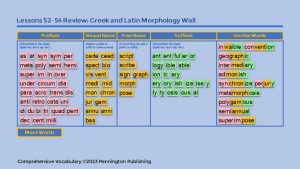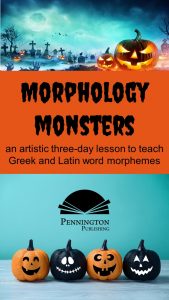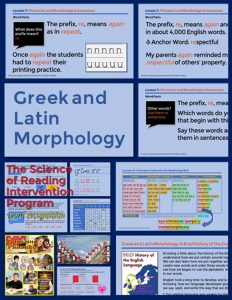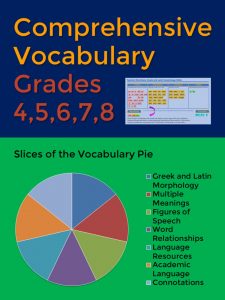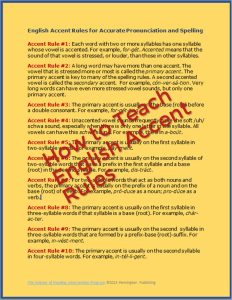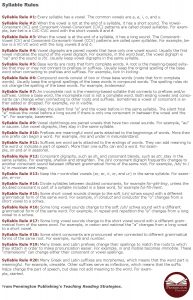
Comprehensive Vocabulary
Vocabulary instruction is vitally important to advanced reading comprehension and writing. Words are the foundations of our language. Students learn the words they need to converse, read, and write in three key ways. First, students learn academic vocabulary through wide reading in a variety of genre at their instructional level. Simply lots of reading does not improve vocabulary. What is read determines what is learned. It may be that most teachers need to increase the textual complexity of class novels and assigned independent reading to maximize vocabulary growth. Second, students improve their vocabulary from becoming more efficient in recognizing context clues and applying the context clue categories to making educated guesses as to the meanings of unknown words. Looking up every word in the dictionary is not advisable. Third, learning high frequency Greek and Latin bases/affixes builds academic vocabulary. Greek and Latinates are found in 50% of all English dictionary entries.
Following are articles, free resources, and teaching tips regarding how to teach vocabulary in the intermediate, middle, and high school grades from the Pennington Publishing Blog. Also, check out the quality instructional programs and resources offered by Pennington Publishing.
Vocabulary
Structured Word Inquiry
Get an entire year of structured word inquiry lessons with word matrices and sums. Plus, learn how to make your own and get the resources you need (for free) to teach the phonological, semantic, and orthographic connections which build morphological awareness.
Diagnostic Academic Language Assessments
Is there a frequency-based academic language set of assessments built on academic words (Tier 2)? Yes, the research-based Academic Words List is the basis for five grade-level assessments, designed in self-correcting Google forms.
Greek and Latin Morphology Walls
Build orthographic, semantic, and phonological connections with Greek and Latin Morphology Walls. Get the free resource of 14 interactive Google slide morphology walls. Drag and drop to build words.
Vocabulary Scope and Sequence
Is there any research about the instructional order of Tier Two words…? Yes. Furthermore, computer generated word frequencies have determined the frequency of Greek and Latin word parts. Check out the Grades 4-8 Vocabulary Scope and Sequence. Teachers and district personnel are authorized to print and share this planning tool.
How to Teach Vocabulary
How to Teach Vocabulary asks and provides possible answers to the How Do the Common Core Authors Suggest We Teach Vocabulary? Why Should We Teach Explicit Vocabulary? Won’t Students Learn More from Independent Reading? Which Vocabulary Words Should We Teach? To Whom Should We Teach Academic Vocabulary? How Much Class Time does it take to teach the Common Core Vocabulary Standards? Check out the grades 4-8 instructional vocabulary scope and sequence.
Teach Morphemes, Not Just Academic Words
My purpose in this article is convince teachers to include high utility and high frequency Greek and Latin meaning-based word parts (morphemes) as part of a balanced vocabulary program. Good vocabulary instruction includes structural analysis (how words are put together), not just a list of tough academic words or difficult words which your students will be reading in a story or in an article. Make sure to download the FREE Greek and Latin resources.
Greek and Latin “Dead” Languages
Although it’s true that no one, other than scholars, speaks and writes in classical Greek or Latin today, both of the languages remain very much alive in their impact upon our culture and language. It’s the Greek and Latin that provides the vocabulary stumbling blocks for your students. Get great Greek and Latin FREE resources.
How to Memorize Greek and Latin Word Parts
Learn the four tips from memory research and get the FREE download of the DUAL Word Parts Worksheet. You’ll love these Greek and Latin word parts resources.
Greek and Latin Vocabulary Research
Looking for the best and most recent vocabulary research regarding the high utility and high frequency Greek and Latin prefixes, roots, and suffixes? It’s all here. Plus, get my take on why American teachers don’t always get the best in research-based resources. Download the FREE 25 Greek and Latin Power Words including the 60 highest utility and highest frequency morphemes. Teach what appears most in Tier 2 academic text.
25 Greek and Latin Power Words
Get this FREE resource of the 60 highest utility and highest frequency Greek and Latin word parts. The 60 word parts are found in over 60,000 words, including their inflections (a conservative total). With our English lexicon of about 600,000 words, these 60 word parts constitute 10% of the words in our language.
English Language History
Why should students know a bit about the history of the English language? Knowing the origin and development of the English language helps students understand the dynamic nature of language. Use this brief lesson for your students to introduce derivations and etymologies. Plus get the four grade-specific vocabulary worksheets, worksheet answers, vocabulary study cards, and a short unit test with answers for grades 4, 5, 6, 7, and 8 compliments of Pennington Publishing.
Research-Based Vocabulary Worksheets
The educational research provides insight as to what makes a vocabulary worksheet an effective instructional strategy for knowledge and/or skills acquisition. Get examples of Common Core aligned vocabulary worksheets.
Academic Language Words
Yes, the Common Core authors view literacy development as a mutual responsibility of all educational stakeholders. Yes, history, science, and technology teachers need to teach domain-specific academic vocabulary. However, there is a difference between academic language and academic vocabulary. The latter is subject/content specific; the former is not. Reading more challenging expository novels, articles, documents, reports, etc. will certainly help students implicitly learn much academic language; however, academic language word lists coupled with meaningful instruction do have their place. So, which word lists make sense?
Time Idioms
For some time, idiomatic expressions involving time have fascinated me. Following is a song, packed with time idioms and their definitions. Seeing how these time idioms are used in context and in relationship to one another helps the reader (and listener) understand each idiom more so than a simple definition or sentence example.
The Ideal Vocabulary Worksheets
If you were to create the ideal vocabulary worksheets for your 4th, 5th, 6th, 7th, or 8thgrade students, what would you include? No doubt, the worksheets would be perfectly aligned to the Common Core Language Strand 4.0, 5.0, and 6.0 Standards (whether your state and district are Common Core or not…) These Standards make sense to any teacher.
There, Their, and They’re
Anything worth teaching is worth teaching well. Students (and even presidents) have problems using the there, their, and they’re words appropriately and spelling them correctly. Indeed, linguists tend to classify the misuse of there, their, and they’re as high stake grammatical errors. Now, this is a great lesson for students!
Morphological Awareness with Greek and Latin
The bulk of Vocabulary Standards are now included in the Language Strand of the Common Core State Standards (CCSS). Greek and Latin affixes (prefixes and suffixes) and roots are key components of five of the grade level Standards: Grades 4-8. Which Greek and Latin affixes and roots should we teach? How many should we teach? How should we teach them?
How to Memorize Greek and Latin Word Parts
Teachers know that teaching the most common Greek and Latin prefixes, roots, and suffixes makes sense to help students build academic language. After all, about 50% of the words in any unabridged dictionary include at least one Greek or Latin affix or root. The question is how can students most efficiently learn these word parts? Rote memorization has a role; however, tapping into the students’ transferable, long-term memories is more effective.
How to Teach the Common Core Vocabulary Standards
What most teachers notice after careful reading of the Common Core Vocabulary Standards is the expected breadth, complexity, and depth of instruction across the grade levels. These vocabulary words require direct, deep-level instruction and practice in a variety of contexts to transfer to our students’ long-term memories. So which instructional strategies make sense to teach the Common Core Vocabulary Standards? And what is the right amount of direct, deep-level vocabulary instruction that will faithfully teach the Common Core Vocabulary Standards without consuming inordinate amounts of class time? Following is a weekly instructional plan to teach the L.4, 5, and 6 Vocabulary Standards.
Why Vocabulary Lists Don’t Work
Teaching vocabulary word lists does not work. The strategy of giving twenty words on Monday and testing on Friday is both inefficient and ineffective. However, three instructional strategies do make sense to help students improve their vocabularies.
How to Improve Your Vocabulary
Knowing common Greek and Latin prefixes, roots, and suffixes will significantly improve one’s vocabulary. In fact, over half of the words in any dictionary contain a Greek or Latin word part. Academic language especially relies on Greek and Latin. This article gives the high frequency word parts to improve anyone’s vocabulary.
How to Teach Prefixes, Roots, and Suffixes
Prefixes, roots, and suffixes: These word parts that are, indeed, the keys to academic vocabulary—the types of words that students especially need to succeed in school. However, most teachers do not know the best instructional methods to teach these important word parts. Learn the techniques that work best.
Context Clues Vocabulary Review Game
This context clues vocabulary review game helps students apply the five major context clues categories to informed word guessing. Using the Pictionary® game, students drawing context clues according to the five categories.
Vocabulary Word Part Games
Students are more likely to use study and practice procedures that are “game-like” and less boring than simple rote memorization. Here are some fun and effective vocabulary word part review games.
Vocabulary Review Games
Students are more likely to use study and practice procedures that are “game-like” and less boring than simple rote memorization. Here are some fun and effective vocabulary review games.
Top 40 Vocabulary Pet Peeves
Here is the list of the Top 40 Vocabulary Pet Peeves that make Americans see read. Read, laugh, and cringe over mistakes that you or your friends make when abusing these words.
How to Memorize Vocabulary
Many people want to improve their vocabularies, but memorization and retention are the key roadblocks. Not everyone has a natural ability to memorize. However, memorization is a skill that can be learned and improved upon with commitment and practice.
How to Teach Precise Vocabulary
Memorizing words with precise denotative and connotative definitions is important. Sloppy use of our language inhibits effective communication and leads to misunderstandings. Learn the techniques to teach vocabulary with precise meanings.
Learn Vocabulary by Reading
Most teachers teach vocabulary inefficiently. Learn the common mistakes that teachers make in vocabulary instruction and how to re-orient vocabulary instruction to help students make real gains in vocabulary acquisition.
Learning Vocabulary from Independent Reading
Most vocabulary beyond the first ten thousand words comes from independent reading. Wide reading of challenging academic text produces the greatest net vocabulary gain.
How to Double Vocabulary Acquisition from Reading Part III
Refining the skills of context clues strategies will help readers increase vocabulary. Wide reading of challenging academic text is the most efficient method of vocabulary acquisition.
How to Teach Multiple Meaning Words Vocabulary
The Common Core Vocabulary Standards are found in the Anchor Standards for Language:
- Multiple Meaning Words and Context Clues (L.4.a.)
- Greek and Latin Word Parts (L.4.a.)
- Language Resources (L.4.c.d.)
- Figures of Speech (L.5.a.)
- Word Relationships (L.5.b.)
- Connotations (L.5.c.)
- Academic Language Words (L.6.0)
Our instructional focus with multiple meaning words is centered on homonyms in these FREE vocabulary worksheets.
Figures of Speech and Idiomatic Expressions (Colloquial Language)
The Common Core State Standards emphasize a balanced approach to vocabulary development. Unlike some of the other ELA Standards, the vocabulary Standards are quite specific and especially so with figures of speech. Download FREE vocabulary worksheets to try out our grades 4–8 Common Core Vocabulary Toolkits.
How to Teach Connotations: Shades of Meaning Vocabulary
Some of our English words are quite imprecise. Whereas the Greeks have at least four words for love, we only have one. How crazy is it that we can say, “I love you darling, and I also love hot dogs” in the same sentence? The writers of the Common Core Vocabulary Standards include connotative vocabulary acquisition in CCSS L.5.c. One great way to teach connotations is with semantic spectrums. Just like a rainbow is a color spectrum, certain vocabulary words can be placed within their own spectrum of meaning (semantics). Check out these FREE vocabulary worksheets with semantic spectrums.
How to Teach Word Relationships Vocabulary
Word relationships help students understand precision of meaning and are included in the Anchor Standards for Language:
- Multiple Meaning Words and Context Clues (L.4.a.)
- Greek and Latin Word Parts (L.4.a.)
- Language Resources (L.4.c.d.)
- Figures of Speech (L.5.a.)
- Word Relationships (L.5.b.)
- Connotations (L.5.c.)
- Academic Language Words (L.6.0)
Get FREE vocabulary worksheets, each including practice in the above Standards.
How to Teach Academic Language Vocabulary
The importance of students acquiring a rich and varied vocabulary cannot be overstated… (Baumann & Kameenui, 1991; Becker, 1977; Stanovich, 1986), but vocabulary instruction has been neither frequent nor systematic in most schools (Biemiller, 2001; Durkin, 1978; Lesaux, Kieffer, Faller, & Kelley, 2010; Scott & Nagy, 1997). But which words? Dr. Averil Coxhead, senior lecturer at the Victoria University of Wellington School of Linguistics and Applied Language Studies developed and evaluated The Academic Word List (AWL) for her MA thesis. The list has 570 word families which were selected according to certain criteria. My Common Core Vocabulary Toolkits have subdivided these word families into grades 4, 5, 6, 7, and 8 programs.
How to Teach Greek and Latin Word Parts Vocabulary
The keys to memorization involve deep learning, association, and continued practice. Students won’t benefit from these Greek and Latin short-cuts by simply learning a list of 20 per week with a quiz on Friday. Instead, a few well-chosen, high frequency Greek and Latin word parts learned well in the word analysis context, associated with each other to develop mental linking, and practiced in the four communicative contexts of listening, speaking, writing, and reading works so much better. Check out how I teach Greek and Latin word parts in these FREE worksheets from my grade 4, 5, 6, 7, and 8 Common Core Vocabulary Toolkits.
*****
For full-year vocabulary programs which include multiple meaning words (L.4.a.), Greek and Latin morphology with Morphology Walls (L.4.a.), figures of speech (L.5.a.), words with special relationships (L.5.b.), words with connotative meanings (L.5.c.), and academic language words (L.6.0), check out the assessment-based grades 4, 5, 6, 7, and 8 Comprehensive Vocabulary.
Get the Grades 4,5,6,7,8 Vocabulary Sequence of Instruction FREE Resource:

Get the Greek and Latin Morphology Walls FREE Resource:

Get the Diagnostic Academic Language Assessment FREE Resource:

More Articles, Free Resources, and Teaching Tips from the Pennington Publishing Blog
 English-Language Arts and Reading Intervention Articles and Resources
English-Language Arts and Reading Intervention Articles and Resources
Bookmark and check back often for new articles and free ELA/reading resources from Pennington Publishing.
*****
Pennington Publishing’s mission is to provide the finest in assessment-based ELA and reading intervention resources for grades 4‒high school teachers. Mark Pennington is the author of many printable and digital programs. Please check out Pennington Publishing for assessment-based resources created for teachers by a fellow teacher.
Literacy Centers, Reading, Spelling/Vocabulary, Study Skills
context clue strategies, context clues, English vocabulary, Greek and Latin, Mark Pennington, morphemes, morphological awareness, morphology, Teaching the Language Strand, vocabulary, vocabulary acquisition, vocabulary activities, vocabulary instruction, vocabulary worksheets, word parts, Words Their Way
